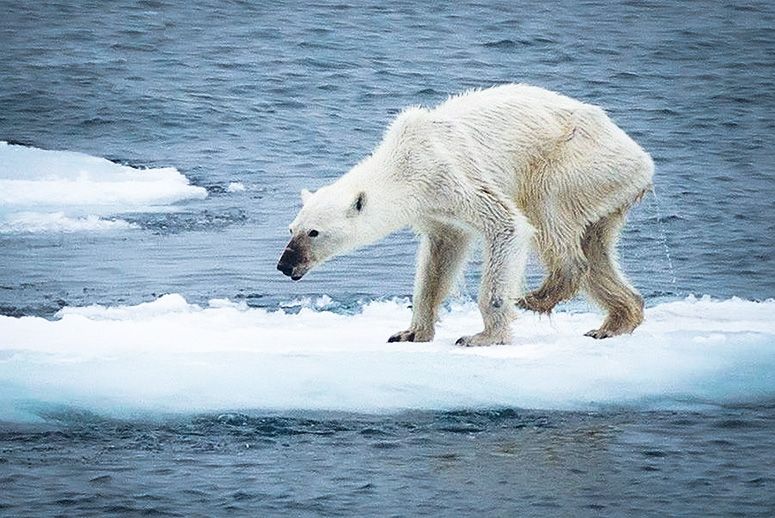German photographer Kerstin Langenberger sighted the bear stranded on an ice floe, its bones visible through its wet fur, in Norway’s Svalbard archipelago, far north of the Arctic Circle. She posted the image to Facebook on Aug. 20, writing that the bear’s terrible condition was not an unusual sight.
The photo quickly made its way from Facebook to other social and viral news media sites.
For the polar bear to survive in the wild, the Arctic must remain extremely cold and largely covered in ice year-round. Unless nations slash burning of coal and oil for energy in the next few decades, scientists believe, Arctic summer sea ice will likely disappear by midcentury, and much of the region will become too warm year-round for polar bears and the ice seals they prey on to thrive.
Extreme warmth in the Arctic has also disrupted the jet stream in recent years, causing severe winter weather in eastern North America and Southeast Asia, and is implicated in this year’s massive wildfire season in Alaska and Canada.
The Svalbard islands are in the Barents Sea, an area of the Arctic Ocean bordered by Scandinavia and Russia. Sea ice there has diminished even more quickly in the past 35 years than on the side of the Arctic bounded by the United States and Canada, putting polar bears in increasing peril.
“I do not have scientific data to proof my observations, but I have eyes to see—and a brain to draw conclusions,” Langenberger wrote about the starving polar bear. “Climate change is happening big deal here in the Arctic.”
Polar bear biologist Geoff York agreed to a point. “Bears get sick,” he said. “Bears get injured. Bears get old, and bears die. Attributing cause is difficult even when we can handle those animals.”
The negative impacts of climate change on the Arctic and on polar bears, however, are beyond argument, said York, senior director of conservation for the nonprofit Polar Bears International, who has 14 years of field experience studying the species. But that doesn’t make it certain that global warming–driven starvation is what caused this polar bear’s deterioration.
“If someone wanted to point a finger to one large fire in California and say that’s climate change, it would be hard to do,” he said. “It’s the same thing here.”
Still, he emphasized, the bear’s condition was consistent with expert forecasts of what is happening as the species becomes cut off from sea ice and seals for longer periods of time.
“There have always been good and bad years in the Arctic for polar bears, and we’re expecting more bad years,” York said, noting that the Barents Sea is now ice-free for 20 weeks more every year than it was in 1979, when satellite measurements of Arctic sea ice began. “Scientists in that part of the world are starting to see effects of that rippling up the food chain.”
On the other side of the Arctic Ocean, summer sea ice dwindled to an area of 1.7 million square miles as of Sept. 11, according to the U.S. National Snow and Ice Data Center. This is its fourth-lowest extent on record, with all four lows occurring since 2010. The extent of 2014–15 winter ice was the lowest ever recorded.
With temperatures in the Arctic warming at twice the rate of lower latitudes, Arctic Ocean ice pack has dropped by 40 percent overall since the late 1970s.
A 2014 study in the journal Nature Geoscience noted, however, that even though 2012 witnessed the lowest summer sea ice extent recorded, the amount of ice recovered substantially in 2013 and 2014. These unexpected freezes were a sign, the authors said, that the Arctic may be able to recover if the world acts quickly to curb climate change.
Source: Alternet | 19 September 2015














